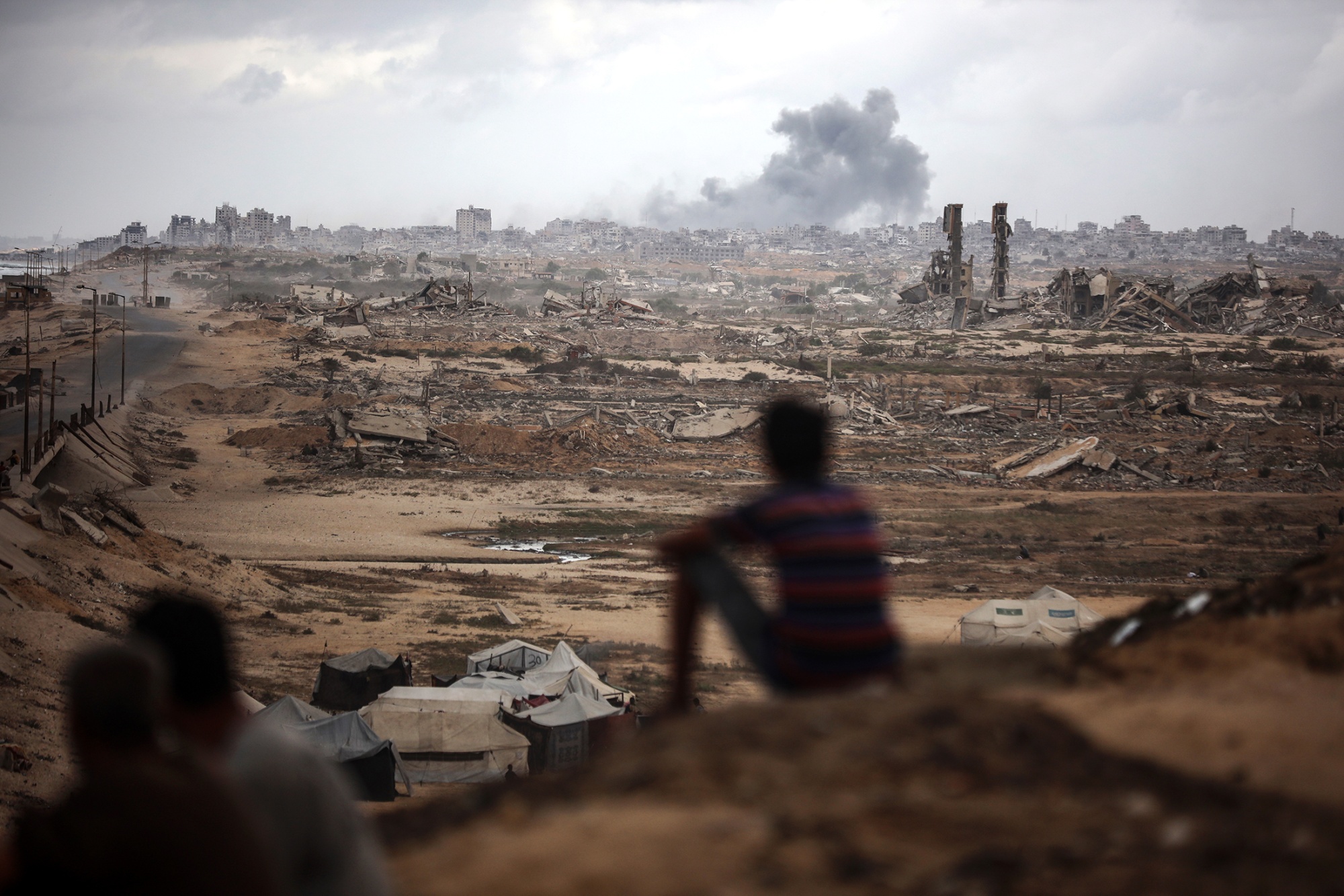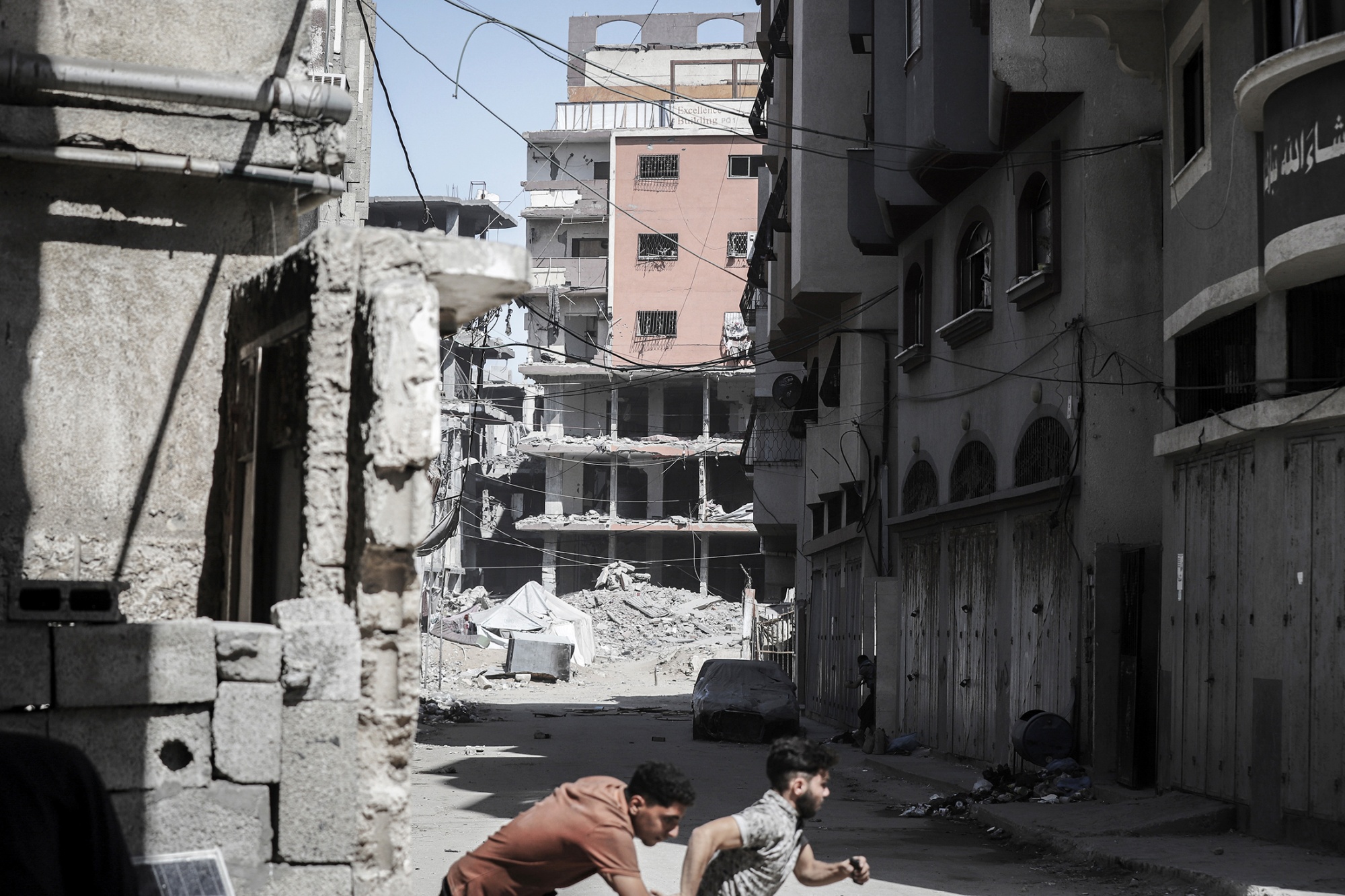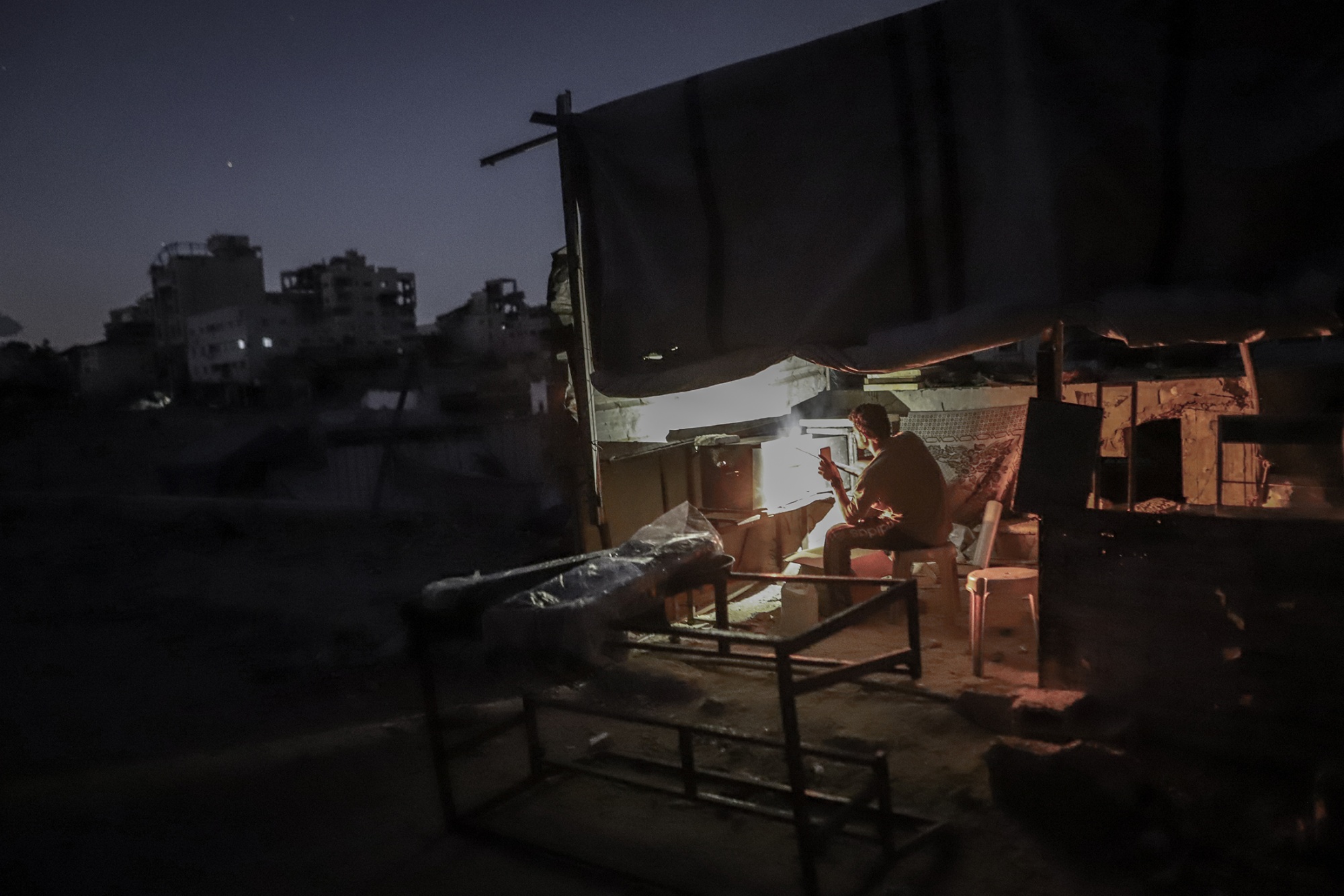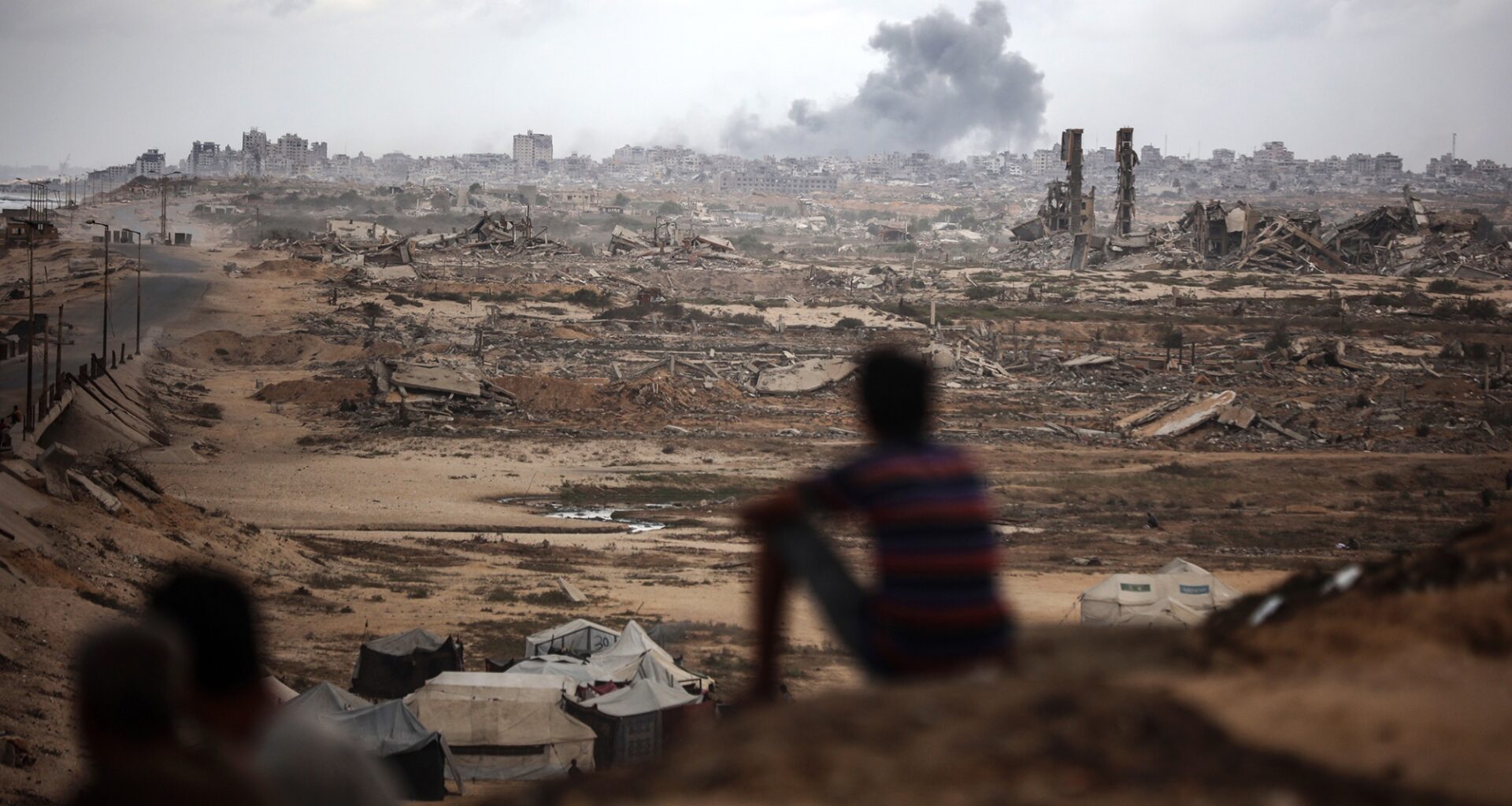 Palestinians walk in a street at night in Gaza City on Oct. 9. Photographer: Ahmad Salem/Bloomberg Most of the 2.2 million population has been internally displaced, and many no longer have homes to return to, even if the fragile ceasefire holds. By Ethan BronnerFadwa HodaliKrishna KarraTom Fevrier October 9, 2025
Palestinians walk in a street at night in Gaza City on Oct. 9. Photographer: Ahmad Salem/Bloomberg Most of the 2.2 million population has been internally displaced, and many no longer have homes to return to, even if the fragile ceasefire holds. By Ethan BronnerFadwa HodaliKrishna KarraTom Fevrier October 9, 2025
A 2-mile-long road running from the Egyptian border to Rafah in southern Gaza is a landscape of rebar and cinderblock, rusting vehicles smashed and overturned, concrete ceilings split apart. The area that was once home to tens of thousands of Palestinians before the Israel-Hamas war, is a collection of ghost towns with virtually every structure obliterated after two years of brutal conflict.
On Thursday, just hours after US President Donald Trump’s announcement that a peace deal had been struck, Bloomberg traveled into the blighted territory with the Israel- and US-backed Gaza Humanitarian Foundation. It operates just north of Rafah and just south of Khan Younis, where a combined 650,000 people lived pre-war. Now hundreds of thousands are packed into tents a few miles from the center in al-Mawasi and other areas designated by Israel as humanitarian zones.
It’s a similar picture across Gaza. Nearly all of the territory’s 2.2 million people are displaced, living in overcrowded camps in a narrow slice of land along the Mediterranean coast that amounts to less than 10% of the entire territory, according to a Bloomberg analysis.
“The world is not ready to see the extent of the devastation in Gaza,” said Rym Momtaz, a Middle East expert and editor-in-chief of Carnegie Europe’s blog, Strategic Europe.
Palestinians Are Crowded Into Tents South of Gaza City
Satellite-detected tent density per 0.25 square km
Source: Bloomberg News analysis of satellite imagery from Planet Labs PBC.
Note: Imagery analyzed includes Oct. 1 to Oct. 7. High density corresponds to tents encompassing more than 75% of land in a 0.25 sq. km. area; low is less than 10%.
While Trump may have secured promises of a ceasefire, turning it into a long term peace will depend on the key challenges — most immediately, feeding and rehousing Gaza’s population, then agreeing governance and how to pay for a costly reconstruction — all while the threats of Hamas rebuilding itself to rekindle the fight or Israel returning to the conflict remain.
“The social structure in Gaza is simply gone,” said Chapin Fay, GHF spokesman. This is a stark assessment from an organization that has come under intense criticism for its cooperation with Israel while more established aid agencies like the United Nations Relief and Works Agency were effectively prevented by Israel from operating in Gaza. There were violent episodes and deaths outside their centers in the first weeks of operation, involving fire from Israeli troops and Hamas, considered a terrorist organization by the US and European Union.
A crowd of women, many with children in tow, lined up for sacks of potatoes and onions to take back to their camp, where they cook on outdoor fires fueled by wood from discarded pallets. Describing how she felt when news of the truce reached her tent, a 38-year-old schoolteacher who asked to be identified only as Jihan said, “It’s like a holiday, we’re so happy.” But, she added, “we are worried, will this food center be here next week? Who will be in charge?”

A smoke plume rises following an Israeli bombardment on the Gaza Strip as seen from northwest of Nuseirat refugee camp in Gaza on Oct. 9. Photographer: Majdi Fathi/NurPhoto/Getty Images
Israel’s cabinet is expected to formally approve the deal. When that happens, its military will redeploy to new lines and 72 hours later, Hamas will hand over the 48 remaining Israeli hostages, 20 of whom are alive. In exchange, Israel will free 1,700 Palestinians detained in Gaza since the fighting began, as well as 250 Palestinian prisoners serving life sentences. And, it will allow vast amounts of humanitarian aid waiting at the border to be delivered, months after its blockade helped spark a famine in parts of the territory, according to a UN-backed body.
“The question now becomes about a pause in hostilities, or a cessation of hostilities” said Mouin Rabbani, non-resident senior fellow at the Middle East Council on Global Affairs. “If it’s a cessation, is it then going to be used to address the underlying political issues, or are we just going back to the situation we had on Oct. 6, 2023 — in other words, all the ingredients for a crisis, for a new explosion will be there.”
The war, which began after Hamas attacked Israel on Oct. 7, 2023, taking some 250 hostages and killing around 1,200 others, has killed at least 67,000 Palestinians, according to the Hamas-run health ministry. Israel says it has been so destructive in Gaza in order to root out the Islamist group, and destroy its underground tunnels and bases. In the so-called humanitarian zone, people, many of whom have been displaced multiple times, have been largely cut off from food and fresh water, as well as sanitation, electricity and medical care, aid agencies say.
Satellite analysis showing damaged buildings and refugee tents reveals the hundreds of thousands of displaced Palestinians who have erected shelters along Gaza’s coastline, as they’ve been forced out of largely destroyed urban areas.
Read More: An Environmental Crisis Haunts the Ruins of Gaza
Sources: Bloomberg News analysis of satellite imagery from Planet Labs PBC. Damage analysis of Copernicus Sentinel-1 satellite data by Corey Scher and Jamon Van Den Hoek of Oregon State University’s Conflict Ecology Lab.
Note: Imagery analyzed combines dates from Oct. 1 – Oct. 4.
This has been by far the longest and most devastating of the four wars Hamas has fought with Israel since 2007, when it took control of Gaza, after ejecting its rival Fatah, which leads the Palestinian Authority that administers parts of the West Bank — the larger of the two Palestinian Territories.
Reconstruction — which the World Bank said in February could cost around $53 billion — and a better future for Gaza, are still a long way off.
For now, the focus is on humanitarian aid, with millions of dollars worth of food and medicine waiting for Israeli approval to be sent into Gaza. Israel is also holding Palestinian tax revenues, transfers that are a main lifeline for the Palestinian Authority. The training and equipping of a stabilization force will require heavy financing — and it’s not clear where the troops or the money will come from.
It took a huge amount of pressure from US, Egyptian, Qatari, and Turkish mediators to get to this point. Everybody agrees the next phase is far from clear.
Trump’s plan doesn’t say Palestinian statehood is a necessity, but nods to it in point 19 of 20, saying that only once reform of the Palestinian Authority and re-development occur, could the conditions be in place for a credible pathway to Palestinian self-determination and statehood — still a far cry from an actual state.
Nor does it mention the fate of the West Bank, where the Israeli military has stepped up its actions against what it says are militant groups, while Israeli settlements have increased and Israeli settler violence against Palestinians has surged. Without addressing this, there is no hope for long-lasting peace.
“I do believe that what was put on the table is the best that could have been achieved given the challenges, the time limits and all that kind of stuff,” said Ghaith al-Omari, a senior fellow at The Washington Institute and adviser to the Palestinian negotiating team in the early 2000s. But there are “real problems that we’re going to have to face.”
Read more: Israel’s Grip on West Bank Erodes Viability of Palestinian State

Palestinians run across a street during an Israeli air strike in Gaza City on Monday, Sept. 29. Photographer: Ahmad Salem/Bloomberg
In Gaza City, where Israel intensified its attacks since August, the picture is stark.
Since early September when Israel expanded its ground offensive in the city, saying it aimed to rout the last remaining Hamas strongholds, nearly a million Palestinians have fled south towards the designated humanitarian zone, some of them getting GHF aid now. About 200,000 people remained in their homes, even as fighting raged and despite evacuation orders, according to the UN.
Israel Has Struck Nearly Three Quarters of Gaza City’s Buildings Buildings damaged and destroyed as of Oct. 1 Damaged areas repeatedly struck since March
Source: Damage analysis of Copernicus Sentinel-1 satellite data by Corey Scher and Jamon Van Den Hoek of Oregon State University’s Conflict Ecology Lab.
Note: Repeat damage captures previously affected areas which have suffered increasingly severe damage or complete destruction.
Analysis of recent satellite images over the city, the territory’s biggest urban center, shows it’s largely cleared out with few tents near the capital’s coast, el-Wafa Hospital and al-Yarmouk Stadium. Satellite analysis from Corey Scher and Jamon Van Den Hoek of Oregon State University’s Conflict Ecology Lab reveals that 18% of the city’s buildings were repeatedly struck during Israel’s recent incursion.
The GHF has been working for four months and says it’s handed out 182 million meals at four centers in southern and central Gaza. Distribution on Thursday was largely orderly, run by an Egyptian-American and a team including Gazans and foreigners with tight security and medical aid provided by Samaritan’s Purse, a US evangelical organization.
“Hamas is under internal pressure,” said one Gazan aid worker at the site, who asked not to be named because he feared he’d be singled out for retribution by the Islamist group. “It’s splitting apart and is at its lowest point since it came to power. Meanwhile, Israel destroyed much of Gaza.”
The food distribution administrator, 48, who lost his home and construction business in the war, said he thinks it will be a decade before Gaza is rebuilt. He added, “The big question is who will absorb all the young people who have nothing to lose now. We need to give them something to live for. What people in Gaza need most is a new public vision so they can have a proper life.”

A Palestinian man lights firewood to bake bread at night in Gaza City on Oct. 9. Photographer: Ahmad Salem/Bloomberg
With assistance from: Dina EsfandiarySamy AdghirniMagdalena Del ValleFares AkramEric MartinRaeedah WahidAlex Newman Edited by: Caroline AlexanderMichael OvaskaMaria WoodNeil Munshi

